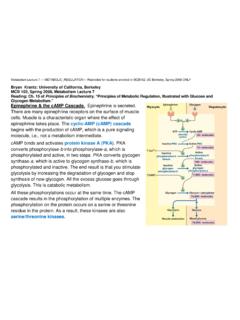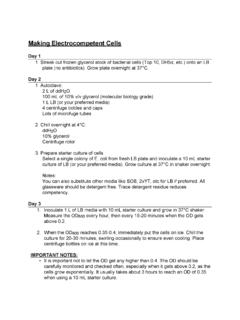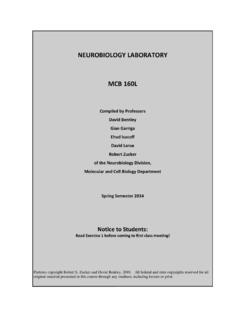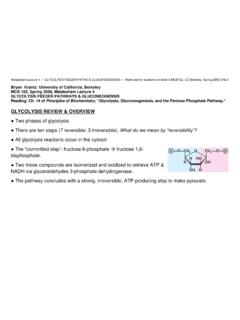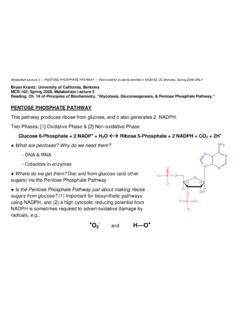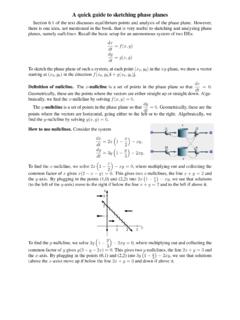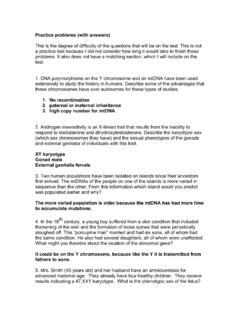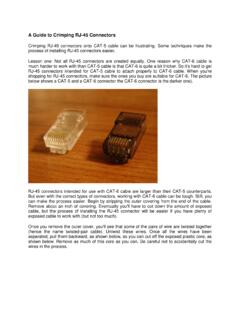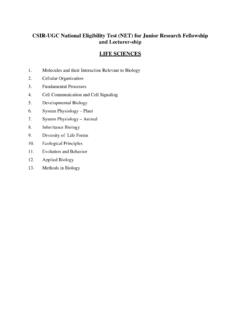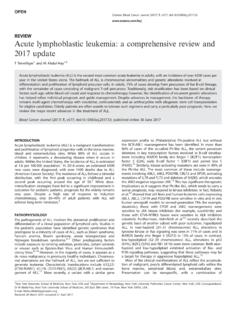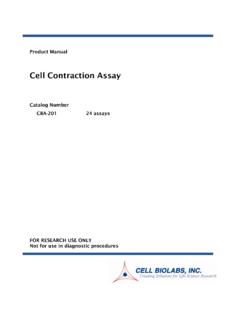Transcription of I Introduction II G Protein-coupled Receptors III Receptor ...
1 MCB110-Spring 2008-NogalesSignaling 15 CELL SIGNALINGI IntroductionA. Types of SignalingB. Types of ReceptorsC. Other Conserved FunctionsII G Protein-coupled ReceptorsA. Heterotrimeric G proteinsB. G-protein coupled receptorsC. Second messenger cAMP: Glucose mobilizationD. Lipid-derived Second MessengersE. Calcium SignalingIII Receptor Tyrosine KinasesA. Insulin ReceptorB. General RTKs, Ras and the MAP kinase cascadeIV Integrin SignalingV Cell signaling and ApoptosisVI Relationships between signaling PathwaysSuggested Reading: Lodish, Chapter 13; Chapter 14, to , Chapter 15 MCB110-Spring 2008-NogalesSignaling 2 Essential to the survival of every cell is tomonitor the environment and to respond toexternal stimuli. For most cells this includesappropriate communication with neighboringcells. Cell signaling (or signal transduction)involves: Detection of the stimulus (in mostcases a molecule secreted by anothercell) on the surface of the plasmamembrane.
2 Transfer of the signal to thecytoplasmic side. Transmission of the signal to effectormolecules and down a signaling pathwaywhere every protein typically changesthe conformation of the next down thepath, most commonly byphosphorylation (by kinases) ordephosphorylation (by phosphatases).The final effect is to trigger a cell sresponse, such as the activation ofgene transcriptionIINTRODUCTION TO signaling PATHWAYSMCB110-Spring 2008-NogalesSignaling 3 MCB110-Spring 2008-NogalesSignaling 4I A Types of SignalingCells communicate by means of extracellular signaling molecules that are producedand released by signaling cells. These molecules recognize and bind to Receptors onthe surface of target cells where they cause a cellular response by means of a signaltransduction on the distance that the signaling molecule has to travel, we can talk aboutthree types of signaling :In endocrine signaling hormones are produce by an endocrine gland and sent through the bloodstream to distant can be: small lipophilic molecules that diffuse through the cell membrane to reachcytosolic or nuclear Receptors .
3 Examples are progesterone and testosterone, as well as thyroidhormones. They generally regulate transcription; or water soluble molecules that bind to receptorson the plasma membrane. They are either proteins like insulin and glucagons, or small, chargedmolecules like histamine and 2008-NogalesSignaling 5In paracrine signaling the signalingmolecule affects only target cells inthe proximity of the signaling cell. Anexample is the conduction of anelectric signal from one nerve cell toanother or to a muscle cell. In this casethe signaling molecule is autocrine signaling cells respond tomolecules they produce include many growth , lipophilic hormones thatbind to membrane Receptors , are often usedin paracrine and autocrine signaling . Theygenerally modulate the effect of a signaling molecule binds to its Receptor it causes a conformational change in it that results in acellular response.
4 The same ligand can bind to different Receptors causing different responses ( ). On the other hand, different ligands binding to different Receptors can produce thesame cellular response ( glucagon, epinephrine).MCB110-Spring 2008-NogalesSignaling 6I B Types of ReceptorsThere are a number of Receptor classes that are used in different signaling two more predominant are:The conformational change in the Receptor upon ligand binding activates a G protein,which in turns activates an effector protein that generates a second 2008-NogalesSignaling 7 These Receptors have a catalytic activity that is activated by binding of the ligand. Anexample are tyrosine-kinase Receptors . Binding of an often dimeric ligand inducesdimerization of the Receptors that leads to cross phosphorylation of the cytosolicdomains and phosphorylation of other 2008-NogalesSignaling 8 Identification and Purification of Cell-Surface ReceptorsHormone Receptors are difficult to identify and purify because they are present invery low abundance and they have to be solubilized with nonionic detergents.
5 Giventheir high specificity and high affinity for their ligands, the presence of a certainreceptor in a cell can be detected and quantified by their binding to radioactively-labeled hormones. The binding of the hormone to a cell suspensions increases withhormone concentration until it reaches Receptor saturation. Specific binding isobtained by measuring both the total and the non-specific binding (which is obtainedby using a large excess on unlabeled hormone).MCB110-Spring 2008-NogalesSignaling 9 The Receptor can be purified insome cases by means of affinitychromatography: the hormone islinked to agarose beads. Crude,solubulized membranes arepassed through a column withthese beads, which will retain onlytheir specific Receptor . Thereceptor is later release bypassing excess hormone throughthe column. A single pass canproduce a 100,00 fold 2008-NogalesSignaling 10In many cases, however, the number of Receptor on the cell surface is to low to usechromatography.
6 An alternative is to produce recombinant Receptor plasmid cDNA library from the cellsexpressing the Receptor is screen bytransfecting the cloned cDNAs into cells thatnormally do not express the Receptor . Cellsthat take up the cDNA encoding the receptorare detected by their binding to fluorescenceor radioactively-labeled hormone. The cDNAcan then be sequenced and used produce largeamounts of recombinant 2008-NogalesSignaling 11 MCB110-Spring 2008-NogalesSignaling 12I C Other Conserved FunctionsThe three main classes of intracellular signaling proteins are:G proteins (GTPase switch proteins) - These proteins change between an activeconformation when bound to GTP, and an inactive conformation when bound to the absence of a signal they are bound to GDP. Signal results in the release ofGDP and the binding of abundant GTP. After a short period of time they hydrolyseGTP and come back to their off 2008-NogalesSignaling 13 Protein Kinases - Upon activation they add phosphate groups to themselves and/orother proteins at either serine/threonine, or at tyrosine residues.
7 Their activity canbe regulated by second messengers, interaction with other proteins, or byphosphorylation itself. They are opposed by phosphatases that remove phosphategroups from specific phosphorylated 2008-NogalesSignaling 14 Adaptor Proteins Many signaling pathways require the formation of large proteincomplexes that are held together by adaptor proteins. These proteins containseveral specialized domains that act as docking sites for other proteins ( SH2domains bind to phosphotyrosines; SH3 domains bind to proline-rich sequences).MCB110-Spring 2008-NogalesSignaling 15II G Proteins and G Protein-coupled ReceptorsIIA - Heterotrimeric G proteinsGTP-binding proteins (or G-proteins) are molecular switchesthat turn activities on and off. Intheir GTP-bound state they areactive and bind to specificproteins downstream, while intheir GDP state they are proteins includeGTPases-activating proteins(GAPs), guanine nucleotide-exchange factors (GEFs) andguanine nucleotide-dissociationinhibitors (GDIs)MCB110-Spring 2008-NogalesSignaling 16II B - G Protein-coupled Receptors Many different mammalian cell-surfacereceptors are coupled to a heterotrimericsignal-transducing G protein, covalentlylinked to a lipid in the membrane.
8 Ligand binding activates the Receptor ,which activates the G protein, whichactivates an effector enzyme to generatean intracellular second messenger. All G Protein-coupled Receptors (GPCRs)contain 7 membrane-spanning regions withtheir N-terminus on the exoplasmic faceand C-terminus on the cytosolic face. Theyare ligand specific and differ in theirextracellular surface. GPCRs are involved in a range of signaling pathways, including light detection, odorantdetection, and detection of certain hormones and neurotransmitters. Seven-helix transmembrane Receptors and heterotrimeric G proteins exist in differentisoforms: epinephrine binding to -adrenergic Receptors in cardiac muscle activates a Gsthat stimulates cAMP production, inducing muscle contraction. Its binding to the -adrenergic Receptor in intestine activates a Gi that inhibits cAMP inducing 2008-NogalesSignaling 17 Activation of the G protein by the binding changes the conformation of the receptorso that it binds the G protein.
9 This in turn causes theexchange of GDP for GTP in the subunit, switching it tothe activated state. While a ligand is bound it can activatemany G protein of the signal to the bound GTP G dissociates from the G complex andis able to bind to its effector molecule. Binding of G causes the activation of the effector. G can in turn alsoactivate downstream the GTP is hydrolyzed the G subunit rebinds to G ,returning the complex to its inactivated state. Althoughthe G generally has a low GTPases activity, this can beaccelerated by interaction with its GAP (see movie)By phosphorylation and binding of arrestinMCB110-Spring 2008-NogalesSignaling 18 MCB110-Spring 2008-NogalesSignaling 19II C Second Messenger cAMPA second messenger is a substance that is released in the cytoplasm followingactivation of a Receptor . It is non-specific and can generate a variety of responses inthe cell.
10 CAMP is an is synthesized by an integral membrane protein, adenylyl cyclase, using ATP as 2008-NogalesSignaling 20 Adenylyl cyclase can be activated or inactivated by different G proteins followingthe binding of an inhibitory or stimulatory ligand to G protein coupled 2008-NogalesSignaling 21 MCB110-Spring 2008-NogalesSignaling 22 Glucose Mobilization Glucose is stored in animal cells as glycogen, an insoluble polymer. The enzyme phosphorylase catalyzes glycogen breakdown, while glycogen synthase catalyzespolymerization. Regulation is achieved by several hormones, such as glucagon (from the pancreas) and epinephrine(from the adrenal medulla). Binding of epinephrine or glucagon totheirreceptors activates adenyl cyclase. cAMP binds to the regulatory subunitof protein kinase A (PKA) causing therelease of the catalytic subunit. PKA phosphorylates and inhibitsglycogen synthase.
